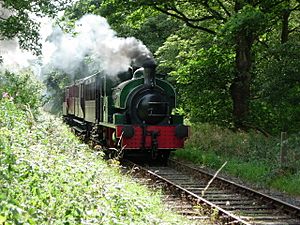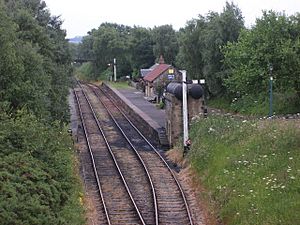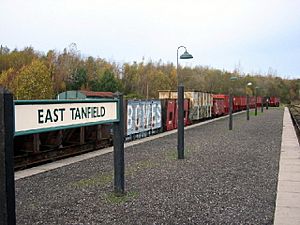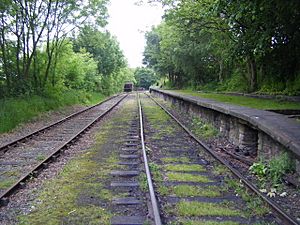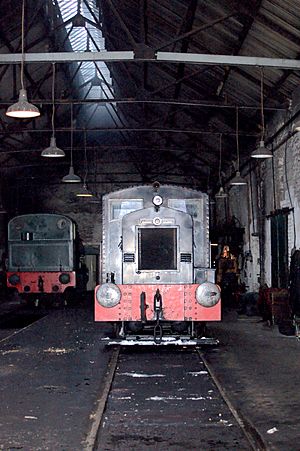Tanfield Railway facts for kids
Quick facts for kids Tanfield Railway |
|
|---|---|
| Locale | North East England |
| Coordinates | 54°54′29″N 1°40′30″W / 54.908°N 1.675°W |
| Commercial operations | |
| Name | Tanfield Railway |
| Original gauge | Wooden Waggonway / Iron 4 ft 8 1⁄2 in (1,435 mm) standard gauge |
| Preserved operations | |
| Stations | 4 |
| Length | 3 miles (4.8 km) |
| Preserved gauge | 4 ft 8 1⁄2 in (1,435 mm) standard gauge |
The Tanfield Railway is a special railway in Gateshead and County Durham, England. It uses old steam trains and runs on a track that was once a horse-drawn coal railway. This railway is called a "heritage railway" because it keeps old trains and tracks working for people to enjoy.
The railway is about 3 miles (4.8 km) long. It goes from East Tanfield, Durham in the south to Sunniside, Gateshead in the north. There are also stations at Andrews House and a stop near the famous Causey Arch. The Tanfield Railway says it is "the world's oldest railway." This is because parts of its track have been used since 1725, and some sections even since 1621.
Volunteers help run the railway. Three groups work together: the Friends of Tanfield Railway, the Tanfield Railway Trust (which owns the railway and its trains), and The Tanfield Railway Company (which operates the trains). The company has different teams, like engineers who fix the trains, and people who run the shops and events.
Contents
History of the Coal Railway
The Tanfield Waggonway was built a long time ago by a group of coal-owning families. They were called the Grand Allies. They started building it around 1720. Their main goal was to move coal from mines in County Durham to the River Tyne. From there, the coal was loaded onto ships and sent to places like southeast England.
This railway was very important because it helped the Grand Allies transport coal all year round. The Tanfield route was used continuously from 1725 until it finally closed in 1964. The oldest part of the railway that is still used today, between Sunniside and Causey, dates back to 1725. This makes it the oldest railway in the world that is still running.
The Marley Hill engine shed was built by 1854. It was used by industries until 1970. This shed is the oldest engine shed in the world that is still used for its original purpose. When the Tanfield Railway started running trains for fun in 1977, they added a curve to connect the Marley Hill shed to the main railway line.
At first, the railway used wooden tracks and horses to pull the wagons. Then, in 1837, they started changing it to steel tracks. By 1840, this change was mostly done. They used stationary steam engines, gravity, and horses to move the coal. In 1881, steam locomotives (trains) took over from the stationary engines and horses. Even though it was mainly for coal, the railway also carried some passengers. The railway closed in 1964 when the last coal mine on the line stopped working.
Bringing the Railway Back to Life
When people started working to save the railway, they first focused on the Marley Hill area. They got the old steam engines ready to run and fixed up the engine shed. They also made sure there was water and electricity. In 1973, two locomotives, No.21 and No.5, were steamed for the public to see. The very first passenger train ran for a week in August 1975.
The preserved railway line was first built from Marley Hill to Sunniside Station. Passenger trains started running on July 2, 1981. Andrews House station, which is just south of the Marley Hill sheds, was finished between 1987 and 1989. It has platforms, a water tower, a station building, and a footbridge.
The first train went south to Causey on July 27, 1991. Then, on October 18, 1992, the first train went even further south to the end of the line at East Tanfield. East Tanfield Station itself opened in 1997. The part of the line between Causey and Tanfield goes through a beautiful wooded area.
One big reason the railway was saved is that the Marley Hill shed stayed open until 1970. The old machines in its workshop can still fix up entire locomotives. The oldest train on the railway was built in Gateshead in 1873. All of the railway's passenger coaches are from the 1800s.
Causey Arch
The railway line passes close to Causey Arch. This is the oldest surviving railway bridge in the world. It was built between 1725 and 1727. The bridge is about 150 ft long (46 m) and 80 ft high (24 m). For 30 years, it was the largest single-span bridge in Britain.
Stations and Important Spots
| Point | Coordinates (Links to map resources) |
OS Grid Ref | Notes |
|---|---|---|---|
| Sunniside | 54°55′14″N 1°40′30″W / 54.9206°N 1.6750°W | ||
| Marley Hill signal box | 54°54′36″N 1°40′33″W / 54.90995°N 1.67580°W | ||
| Marley Hill engine sheds | 54°54′35″N 1°40′43″W / 54.9097°N 1.6786°W | ||
| Andrews House | 54°54′32″N 1°40′33″W / 54.9089°N 1.6758°W | ||
| Causey Arch | 54°53′50″N 1°41′13″W / 54.8972°N 1.6869°W | ||
| for Causey Arch | 54°53′51″N 1°41′16″W / 54.8975°N 1.6877°W | ||
| East Tanfield | 54°53′19″N 1°41′59″W / 54.8885°N 1.6997°W |
Steam Locomotives
As of 2023, the Tanfield Railway has a large collection of old industrial steam engines. There are 28 in total, and four of them are currently running.
Running Locomotives
| Number and name | Description | Status | Owner(s) | Built | Photo |
|---|---|---|---|---|---|
| Hawthorn Leslie and Company 0-4-0ST, No.2. | Built in 1911. It returned to service in 2013 after a big repair. It was taken out of service in December 2021 for another repair. It passed its boiler test in February 2023 and is now running again. | Operational | Tanfield Railway Trust | 1911 | 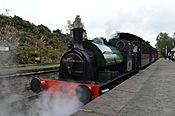 |
| 0-4-0ST Sir Cecil A Cochrane | Built in 1948. It often pulls passenger trains and sometimes a short coal train. It recently had a major 10-year check-up. | Operational | Private | 1948 | 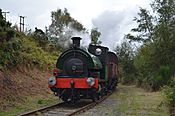 |
| Andrew Barclay 0-6-0ST No. 1015 "Horden" | This engine has been getting fixed since August 2012. It started carrying passengers in June 2021. | Operational | Private | 1904 | 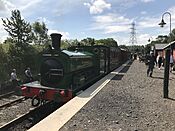 |
| Andrew Barclay No. 32 Stanley 0-4-0ST | It returned to service in June 2023 after a long repair. | Operational | Private | 1920 | |
| Robert Stephenson and Hawthorns 0-6-0ST NCB No. 49 | Built in 1943. It passed its steam test on March 27, 2018, which means it can run until March 27, 2028. It started pulling passenger trains again in July. | Operational | Private | 1943 | 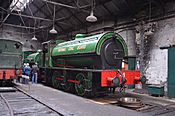 |
Locomotives Being Repaired
| Number and name | Description | Status | Owner(s) | Built | Photo |
|---|---|---|---|---|---|
| 0-6-0T Twizell | Built in 1891. It is on loan from Beamish Museum. After a 15-year repair, it ran again in 2010. In late 2018, it was taken out of service for more repairs. | Undergoing overhaul | Beamish Museum | 1891 | 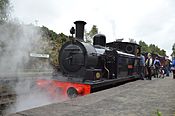 |
| Hudswell Clarke 0-6-0T No. 38 | Built in 1949. It is currently being fixed up in the Marley Hill yard. | Undergoing Restoration | Rising Sun locomotive Trust | 1949 |
Stored Locomotives
| Number and name | Description | Status | Owner(s) | Built | Photo | |
|---|---|---|---|---|---|---|
| Robert Stephenson and Hawthorns No.38 0-6-0ST | Built in 1954. It is currently stored and partly taken apart. It might get a new paint job soon. | Stored | Private | 1954 | 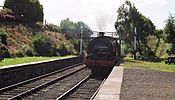 |
|
| Hawthorn Leslie 0-6-0ST Stagshaw | Built in 1923. It was changed into a regular steam locomotive in 1927. It is currently stored at the Tanfield Railway. | Stored | Private | 1923 | 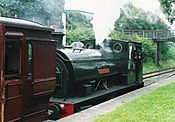 |
|
| Black, Hawthorn & Co 0-4-0ST, Wellington | This is the oldest locomotive on the railway, built in 1873. It was moved for repairs in September 2019, but the work stopped. It was brought back to Marley Hill in May 2021 and will be fixed there. | Stored awaiting overhaul | Private | 1873 | ||
| Hawthorn Leslie "Cyclops" 0-4-0ST | This engine is now stored at the Marley Hill Site. | Stored | 1907 | |||
| Hudswell Clarke 0-4-0ST, Irwell | This engine is stored in many pieces around the Marley Hill site. It might be chosen for repairs in the future. | Stored | Private | 1937 | ||
| Robert Stephenson and Hawthorns 0-4-0ST, No.21 | This engine is stored indoors and might be repaired. It used to move coal at power stations. | Stored | Private | 1954 | 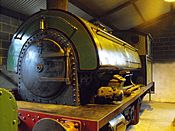 |
|
| Sentinel 0-4-0T No.4 | This engine is stored outside at Marley Hill. It looks like a diesel train but is actually a steam engine. It might be repaired. | Stored | Private | 1953 |  |
|
| W.G. Bagnall 0-6-0ST, Gamma | This engine is stored inside the Marley Hill Engine Shed. You can see it when the site is open. | Stored | Private | 1945 | ||
| Robert Stephenson and Hawthorns Hendon 0-4-0TC | This is one of four crane tanks left from a shipyard. It is currently stored. | Stored | 1940 | 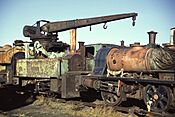 |
||
| Hawthorn Leslie No.13 0-4-0ST | This engine is currently not at the site. It came from a power station. | Stored | 1928 | |||
| Andrew Barclay No.6 0-4-2ST | This engine is currently stored. | Stored | 1910 | |||
| Robert Stephenson and Hawthorns No.44 0-6-0ST | This engine is currently stored in Marley Hill yard. It is missing its water tank and the top of its cab. | Stored | 1953 |  |
||
| Robert Stephenson and Hawthorns No.47 0-6-0ST | This engine is currently stored. | Stored | 1954 |  |
||
| Robert Stephenson and Hawthorns No.16 0-6-0ST | This engine is currently stored. | Stored | 1957 |  |
||
| Hawthorn Leslie No.3 0-6-0ST | This engine is currently stored. | Stored | ||||
| Hawthorn Leslie Huncoat No.3 0-6-0F | This fireless locomotive is currently stored. | Stored | 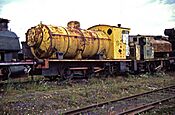 |
|||
| R and W Hawthorn "Enterprise" 0-4-0ST |
Diesel and Electric Locomotives
The railway also has several diesel and electric locomotives. Some are running, and others are on display or waiting for repairs.
- AEG Bo-BoWE no. 1565 / NCB No.9, built in 1913. It is on display in Marley Hill Yard.
- Andrew Barclay Sons & Co. 0-6-0DH no. 615, built in 1977. It is currently running.
- Armstrong Whitworth 0-4-0DE no. D22, built in 1933. It is currently running.
- English Electric and Baguley 2-2wDHR no. 3565, built in 1962. It is on display.
- F.C. Hibberd & Co Ltd Planet 4wDM no. 3716, built in 1955. It is currently running.
- Fowler 0-6-0DH no. 4240010 No. 6, built in 1960. It is currently running.
- Hawthorn Leslie 4w-4wBE no. 3872 Derek Shepherd, built in 1936. It is on display.
- Hunslet Engine Company 0-6-0DH no. 6612 No. 501, built in 1965. It is stored and waiting for repairs.
- Robert Stephenson and Hawthorns 0-4-0DM no. 6980 Camel, built in 1940. It is on display.
- Robert Stephenson and Hawthorns 0-6-0DM no. 7697 Beryl, built in 1953. It is on display.
- Robert Stephenson and Hawthorns 0-6-0DM no. 7746 Bromborough No. 2, built in 1954. It is on display.
- Robert Stephenson and Hawthorns 0-4-0DM no. 7901 Husky, built in 1958. It is currently running.
- Robert Stephenson and Hawthorns Bo-BoWE no. 7078 Kearsley No. 3, built in 1944. It is on display.
- Ruston and Hornsby 0-4-0DE no. 418600 T.I.C No. 35, built in 1958. It is currently running.
- Siemens 4wWE no. 862 / NCB No.10, built in 1913. It is on display and has been nicely restored.
- Key to locomotive types
- BE = battery-electric (runs on batteries)
- DE = diesel-electric (uses a diesel engine to make electricity for motors)
- DH = diesel-hydraulic (uses a diesel engine and hydraulic fluid to move)
- DM = diesel-mechanical (uses a diesel engine and gears to move)
- WE = overhead wire electric (gets power from wires above the track)
Passenger Coaches
All the passenger coaches on the railway are old, wooden coaches from the Victorian era (the 1800s).
- TR No.1 Open Balcony Coach (used to be a GWR Van)
- TR No.2 Open Balcony Coach (used to be a GWR van)
- TR No.3 Open Coach with Guards Van (used to be an LNER Ballast brake van)
- TR No.4 Open Coach with Guards Van (used to be an LNER Ballast brake van)
- TR No.5 Compartment Coach (originally a GNR Coach)
- TR No.6 Compartment Coach (originally a GNR Coach)
- TR No.7 Open Poppleton Coach with Guards Van (originally an NER Director's Saloon)
- TR No.8 Compartment Coach with Guards Van (originally an MS&L Brake Van)
- NER No.256 Compartment Coach (built 1878)
- NER No.818 Compartment Coach
- NER No.A15 Compartment bogie carriage
The railway also has other coaches that are not yet restored.
More Pictures


